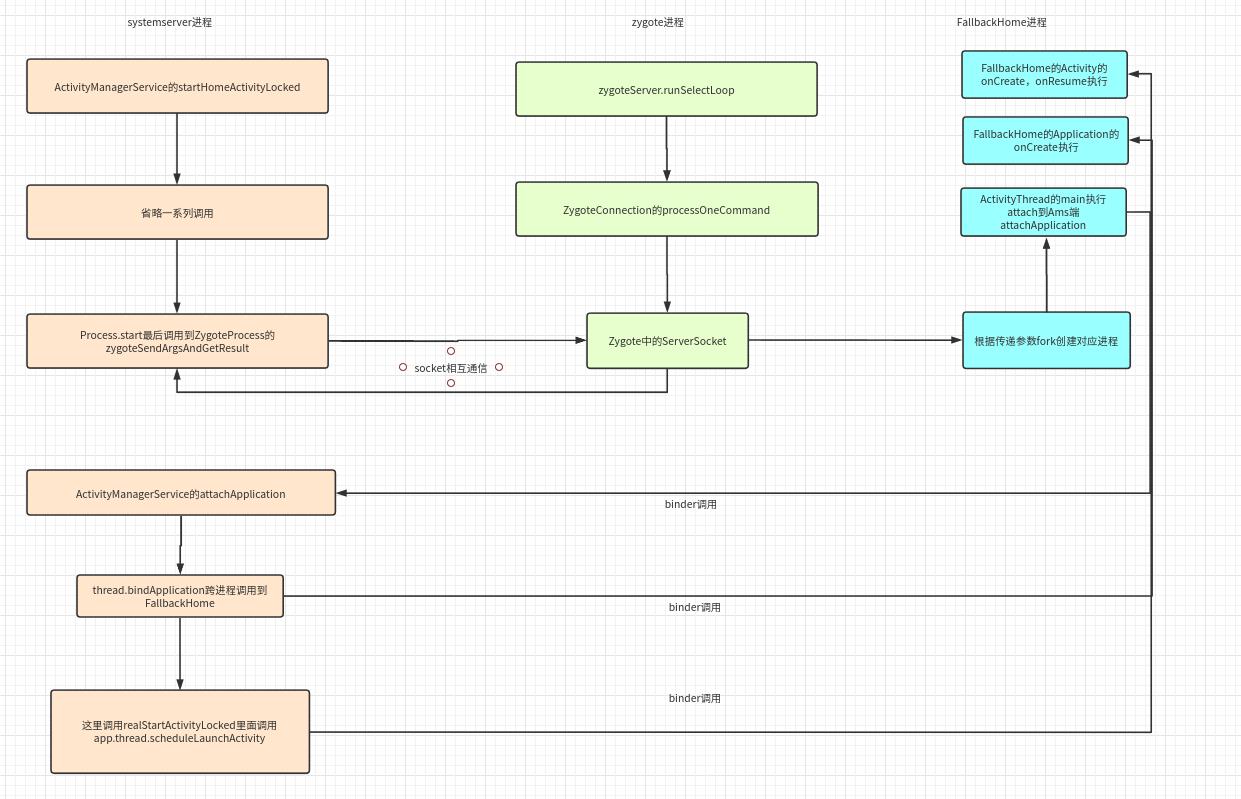Android Framework实战视频--FallbackHome进程启动及Activity启动篇
Posted learnframework
tags:
篇首语:本文由小常识网(cha138.com)小编为大家整理,主要介绍了Android Framework实战视频--FallbackHome进程启动及Activity启动篇相关的知识,希望对你有一定的参考价值。
课程答疑和新课信息:QQ交流群:422901085进行课程讨论
FrameWork入门课视频链接:https://edu.csdn.net/course/detail/30298
FrameWork实战课1视频链接:https://edu.csdn.net/course/detail/30275
专题博客系列:
Android 8.1 zygote 启动过程源码
Android Framework实战视频–Zygote的fork进程篇
Android Framework实战视频–SystemServer启动篇
Android Framework实战视频–SystemServer启动FallbackHome篇
Android Framework实战视频–FallbackHome进程启动及Activity启动篇
Android Framework实战视频–FallbackHome结束启动Launcher篇
android Framework实战视频–FallbackHome进程启动及Activity启动篇
android 8.1 源码中FallbackHome进程启动及Activity启动分析
上一节课已经一步步分析到了Process.start了,那本节就是来分析Process的start方法具体是怎么一步步的把进程启动及进程启动后对应的Activity是怎么启动的
1 应用进程的创建
首先看Process.start的源码:
public static final ProcessStartResult start(final String processClass,
final String niceName,
int uid, int gid, int[] gids,
int debugFlags, int mountExternal,
int targetSdkVersion,
String seInfo,
String abi,
String instructionSet,
String appDataDir,
String invokeWith,
String[] zygoteArgs) {
return zygoteProcess.start(processClass, niceName, uid, gid, gids,
debugFlags, mountExternal, targetSdkVersion, seInfo,
abi, instructionSet, appDataDir, invokeWith, zygoteArgs);
}
这里调用了ZygoteProcess的start方法:
public final Process.ProcessStartResult start(final String processClass,
final String niceName,
int uid, int gid, int[] gids,
int debugFlags, int mountExternal,
int targetSdkVersion,
String seInfo,
String abi,
String instructionSet,
String appDataDir,
String invokeWith,
String[] zygoteArgs) {
try {
return startViaZygote(processClass, niceName, uid, gid, gids,
debugFlags, mountExternal, targetSdkVersion, seInfo,
abi, instructionSet, appDataDir, invokeWith, zygoteArgs);
} catch (ZygoteStartFailedEx ex) {
Log.e(LOG_TAG,
"Starting VM process through Zygote failed");
throw new RuntimeException(
"Starting VM process through Zygote failed", ex);
}
}
这里调用到了startViaZygote方法:
private Process.ProcessStartResult startViaZygote(final String processClass,
final String niceName,
final int uid, final int gid,
final int[] gids,
int debugFlags, int mountExternal,
int targetSdkVersion,
String seInfo,
String abi,
String instructionSet,
String appDataDir,
String invokeWith,
String[] extraArgs)
throws ZygoteStartFailedEx {
ArrayList<String> argsForZygote = new ArrayList<String>();
// --runtime-args, --setuid=, --setgid=,
// and --setgroups= must go first
argsForZygote.add("--runtime-args");
argsForZygote.add("--setuid=" + uid);
argsForZygote.add("--setgid=" + gid);
//省略
synchronized(mLock) {
return zygoteSendArgsAndGetResult(openZygoteSocketIfNeeded(abi), argsForZygote);
}
}
这里设置了一系列参数后,在调用zygoteSendArgsAndGetResult
private static Process.ProcessStartResult zygoteSendArgsAndGetResult(
ZygoteState zygoteState, ArrayList<String> args)
throws ZygoteStartFailedEx {
try {
//省略
final BufferedWriter writer = zygoteState.writer;
final DataInputStream inputStream = zygoteState.inputStream;
writer.write(Integer.toString(args.size()));
writer.newLine();
for (int i = 0; i < sz; i++) {
String arg = args.get(i);
writer.write(arg);
writer.newLine();
}
writer.flush();
// Should there be a timeout on this?
Process.ProcessStartResult result = new Process.ProcessStartResult();
// Always read the entire result from the input stream to avoid leaving
// bytes in the stream for future process starts to accidentally stumble
// upon.
result.pid = inputStream.readInt();
result.usingWrapper = inputStream.readBoolean();
if (result.pid < 0) {
throw new ZygoteStartFailedEx("fork() failed");
}
return result;
} catch (IOException ex) {
zygoteState.close();
throw new ZygoteStartFailedEx(ex);
}
}
zygoteSendArgsAndGetResult这里就调用了BufferedWriter的writer对象进行了socket的写入数据,writer就是zygoteState.writer,
那zygoteState.writer又具体是怎么赋值的呢?
public static ZygoteState connect(String socketAddress) throws IOException {
DataInputStream zygoteInputStream = null;
BufferedWriter zygoteWriter = null;
final LocalSocket zygoteSocket = new LocalSocket();
try {
//连接zygote进程的serversocket
zygoteSocket.connect(new LocalSocketAddress(socketAddress,
LocalSocketAddress.Namespace.RESERVED));
//socket中的输入流
zygoteInputStream = new DataInputStream(zygoteSocket.getInputStream());
//socket中的输出流
zygoteWriter = new BufferedWriter(new OutputStreamWriter(
zygoteSocket.getOutputStream()), 256);
} catch (IOException ex) {
try {
zygoteSocket.close();
} catch (IOException ignore) {
}
throw ex;
}
String abiListString = getAbiList(zygoteWriter, zygoteInputStream);
Log.i("Zygote", "Process: zygote socket " + socketAddress + " opened, supported ABIS: "
+ abiListString);
return new ZygoteState(zygoteSocket, zygoteInputStream, zygoteWriter,
Arrays.asList(abiListString.split(",")));
}
这里面的socketAddress是如下代码赋值的:
public static final ZygoteProcess zygoteProcess =
new ZygoteProcess(ZYGOTE_SOCKET, SECONDARY_ZYGOTE_SOCKET);
public static final String ZYGOTE_SOCKET = "zygote";
也就是ZYGOTE_SOCKET变量,变量就是前几节课讲的zygote进程创建的Server名字
frameworks/base/core/java/com/android/internal/os/ZygoteInit.java中的main方法中:
String socketName = "zygote";
所以就是这样ActivtiyManagerService通过socket与zygote进行一个跨进程通信。

ActivityManagerService这边把要创建一个进程的主要参数等需要准备好,然后发送给zygote端,zygote端接受到了发来数据后创建对应的进程。创建对应进程时候还会执行传过来的entryPoint即 "android.app.ActivityThread"类的main方法
接下来看看分析之前Zygote部分的接受和创建进程,前面zygote已经知道,zygote本身是一直循环执行runSelectLoop里面的While:
Runnable runSelectLoop(String abiList) {
//省略;
while (true) {
//省略;
for (int i = pollFds.length - 1; i >= 0; --i) {
if ((pollFds[i].revents & POLLIN) == 0) {
continue;
}
if (i == 0) {
//如果是本身serverSocket的fd有输入消息,则保存住新建连接的客户端peer和fd,比如:第一次AMS就需要绑定
ZygoteConnection newPeer = acceptCommandPeer(abiList);
peers.add(newPeer);
fds.add(newPeer.getFileDesciptor());
} else {
try {
//如果哪个peer或者fd有消息了,则processOneCommand读取里面消息
ZygoteConnection connection = peers.get(i);
final Runnable command = connection.processOneCommand(this);
if (mIsForkChild) {
//省略
return command;
}
}
}
所以核心在processOneCommand方法:
Runnable processOneCommand(ZygoteServer zygoteServer) {
String args[];
Arguments parsedArgs = null;
FileDescriptor[] descriptors;
try {
//读取发送过来的参数
args = readArgumentList();
descriptors = mSocket.getAncillaryFileDescriptors();
}
//省略
parsedArgs = new Arguments(args);
//省略
//根据参数创建对应的进程,这里本质和以前分析system server进程创建一样
pid = Zygote.forkAndSpecialize(parsedArgs.uid, parsedArgs.gid, parsedArgs.gids,
parsedArgs.debugFlags, rlimits, parsedArgs.mountExternal, parsedArgs.seInfo,
parsedArgs.niceName, fdsToClose, fdsToIgnore, parsedArgs.instructionSet,
parsedArgs.appDataDir);
try {
if (pid == 0) {
//省略
return handleChildProc(parsedArgs, descriptors, childPipeFd);
}
//省略
}
这里processOneCommand创建好了进程后,又调用handleChildProc方法:
private Runnable handleChildProc(Arguments parsedArgs, FileDescriptor[] descriptors,
FileDescriptor pipeFd) {
//省略
//这里最后调用ZygoteInit.zygoteInit和以前systemserver其实是一样的,只不过这里的remainingArgs参数变成ActivityThread
return ZygoteInit.zygoteInit(parsedArgs.targetSdkVersion, parsedArgs.remainingArgs,
null /* classLoader */);
}
/这里最后调用ZygoteInit.zygoteInit和以前systemserver其实是一样的,只不过这里的remainingArgs参数变成ActivityThread类,返回的ActivityThread的main方法执行的Runable
2 应用进程的Activity启动
当应用进程被创建后,最开始就是执行的ActivityThread的main方法
public static void main(String[] args) {
//省略
Process.setArgV0("<pre-initialized>");
Looper.prepareMainLooper();
//创建ActivityThread对象,并且调用attach方法
ActivityThread thread = new ActivityThread();
thread.attach(false);
if (sMainThreadHandler == null) {
sMainThreadHandler = thread.getHandler();
}
if (false) {
Looper.myLooper().setMessageLogging(new
LogPrinter(Log.DEBUG, "ActivityThread"));
}
// End of event ActivityThreadMain.
Trace.traceEnd(Trace.TRACE_TAG_ACTIVITY_MANAGER);
Looper.loop();
throw new RuntimeException("Main thread loop unexpectedly exited");
}
这里主要就是对loop进行初始化,接下来再创建ActivityThread对象,调用它的attach方法:
private void attach(boolean system) {
if (!system) {
//省略
RuntimeInit.setApplicationObject(mAppThread.asBinder());
final IActivityManager mgr = ActivityManager.getService();
try {
mgr.attachApplication(mAppThread);
} catch (RemoteException ex) {
throw ex.rethrowFromSystemServer();
}
//省略
}
//省略
}
这里主要应用端会获取system server中的AMS对象IBinder对象,然后调用attachApplication(mAppThread)方法,这个attachApplication真正实现那是在ActivityManagerService:
@Override
public final void attachApplication(IApplicationThread thread) {
synchronized (this) {
//省略
attachApplicationLocked(thread, callingPid);
//省略
}
}
这里又调用重载方法:private final boolean attachApplicationLocked(IApplicationThread thread,
int pid);
private final boolean attachApplicationLocked(IApplicationThread thread,
int pid) {
//省略
//跨进程调用,执行对应进程的Application的onCreate等方法
thread.bindApplication(processName, appInfo, providers, null, profilerInfo,
null, null, null, testMode,
mBinderTransactionTrackingEnabled, enableTrackAllocation,
isRestrictedBackupMode || !normalMode, app.persistent,
new Configuration(getGlobalConfiguration()), app.compat,
getCommonServicesLocked(app.isolated),
mCoreSettingsObserver.getCoreSettingsLocked(),
buildSerial);
//省略。。
if (mStackSupervisor.attachApplicationLocked(app)) {
//省略。。
return true;
}
这里调用StackSupervisor.attachApplicationLocked(app):
boolean attachApplicationLocked(ProcessRecord app) throws RemoteException {
//省略
if (realStartActivityLocked(activity, app,
top == activity /* andResume */, true /* checkConfig */)) {
didSomething = true;
}
//省略
return didSomething;
}
这里又会调用到realStartActivityLocked方法:
final boolean realStartActivityLocked(ActivityRecord r, ProcessRecord app,
boolean andResume, boolean checkConfig) throws RemoteException {
//省略
app.thread.scheduleLaunchActivity(new Intent(r.intent), r.appToken,
System.identityHashCode(r), r.info,
// TODO: Have this take the merged configuration instead of separate global
// and override configs.
mergedConfiguration.getGlobalConfiguration(),
mergedConfiguration.getOverrideConfiguration(), r.compat,
r.launchedFromPackage, task.voiceInteractor, app.repProcState, r.icicle,
r.persistentState, results, newIntents, !andResume,
//省略
return true;
}
这里最后跨进程调回应用进程,ActivityThread的ApplicationThread的scheduleLaunchActivity方法,这个方法再进行Activtiy的onCreate等调用,这里就不带大家分析ActivityThread的相关内容了,因为ActivityThread中基本属于应用层自己执行代码,而且相对不那么复杂,自己完全可以分析,所以当作作业留给大家自己分析接下来的ActivityThread部分。
最后附上对应的流程总图:

以上是关于Android Framework实战视频--FallbackHome进程启动及Activity启动篇的主要内容,如果未能解决你的问题,请参考以下文章